Nestle's HRM: Recruitment, Selection, Training for Global Markets
VerifiedAdded on 2021/02/20
|23
|5040
|80
Report
AI Summary
This report examines Nestle's human resource management (HRM) strategies, focusing on recruitment, selection, and training practices within a global context. The study aims to evaluate the effectiveness of these strategies in meeting international requirements. The report begins with an introduction to globalization and international HRM, highlighting the significance of effective HRM in multinational corporations like Nestle. It outlines the research aims, objectives, and questions, followed by a detailed project management plan, including cost, scope, time, quality, communication, and resource considerations. A Gantt chart and work breakdown structure are provided to illustrate project timelines and task organization. The research methodology encompasses research philosophy, approach, design, data collection methods (including questionnaires), data sampling (random sampling of 20 Nestle managers), and data analysis techniques. The report delves into the importance of these methodologies for making informed business decisions. The data analysis section presents the findings and interpretation of the collected data, leading to recommendations for improving Nestle's HRM strategies. A reflection on the research process and conclusions summarizing the key findings are also included, along with a list of references and appendices containing the questionnaire, project logbook, and performance review forms. The report provides a comprehensive overview of Nestle's HRM strategies, offering valuable insights into the challenges and opportunities of managing human resources in a globalized business environment.
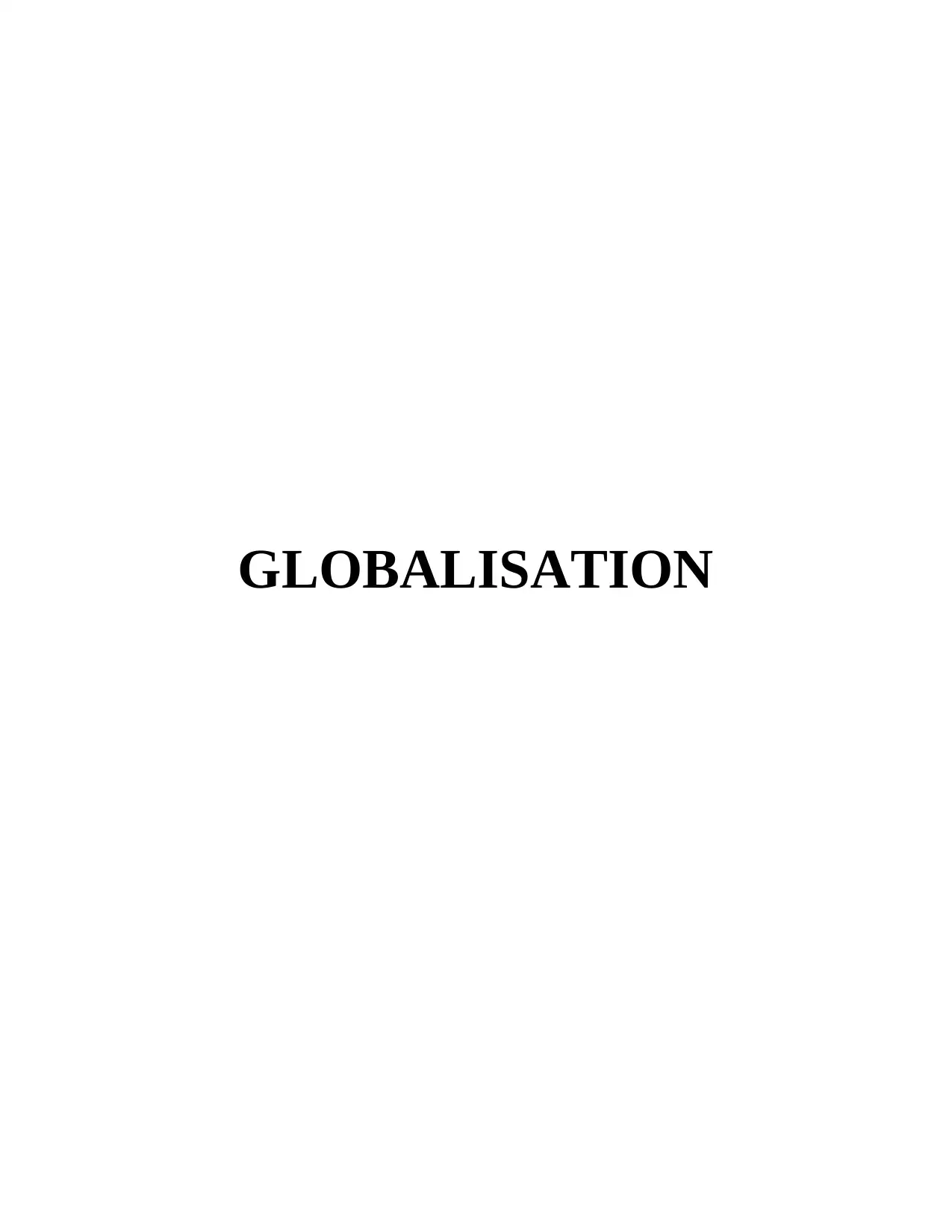
GLOBALISATION
Paraphrase This Document
Need a fresh take? Get an instant paraphrase of this document with our AI Paraphraser
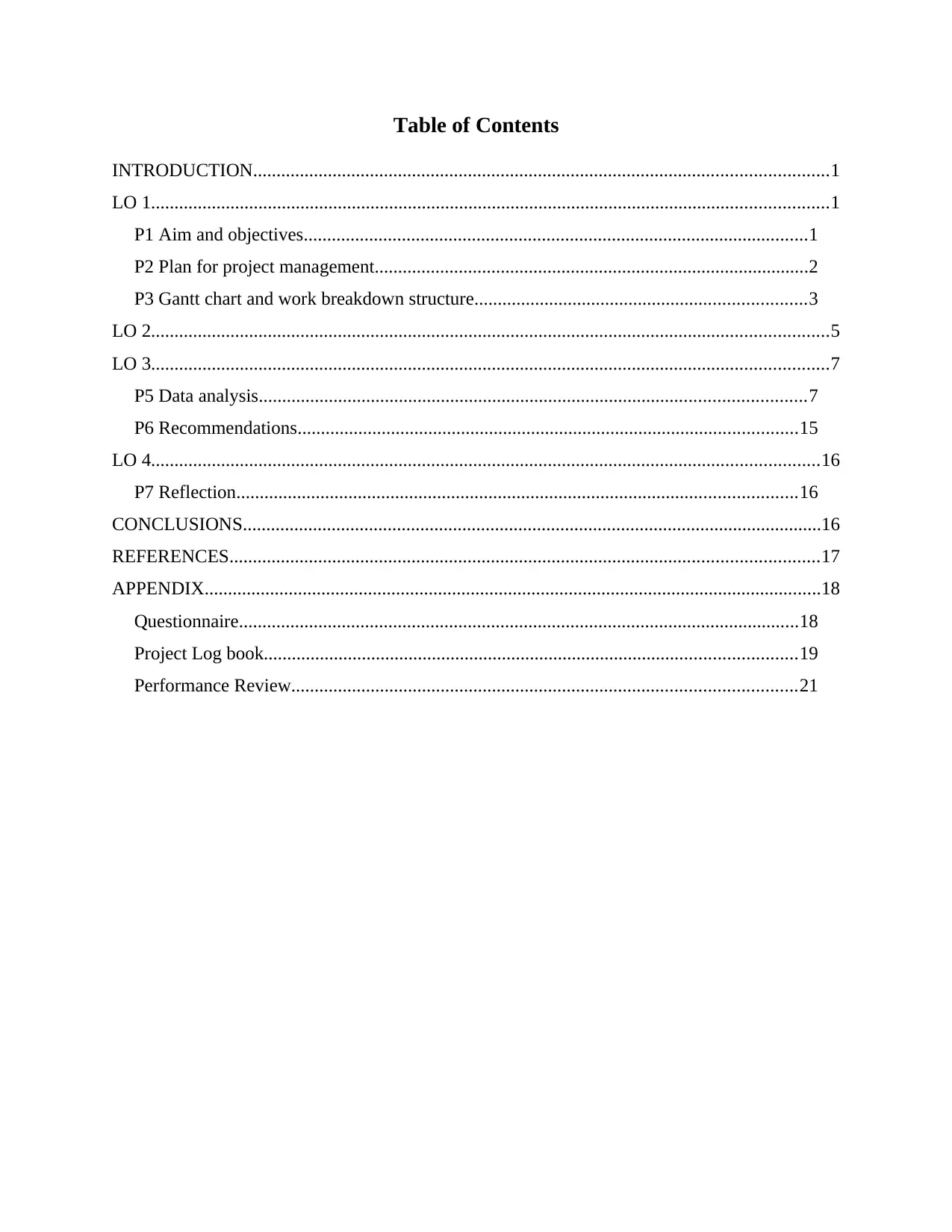
Table of Contents
INTRODUCTION...........................................................................................................................1
LO 1.................................................................................................................................................1
P1 Aim and objectives............................................................................................................1
P2 Plan for project management.............................................................................................2
P3 Gantt chart and work breakdown structure.......................................................................3
LO 2.................................................................................................................................................5
LO 3.................................................................................................................................................7
P5 Data analysis.....................................................................................................................7
P6 Recommendations...........................................................................................................15
LO 4...............................................................................................................................................16
P7 Reflection........................................................................................................................16
CONCLUSIONS............................................................................................................................16
REFERENCES..............................................................................................................................17
APPENDIX....................................................................................................................................18
Questionnaire........................................................................................................................18
Project Log book..................................................................................................................19
Performance Review............................................................................................................21
INTRODUCTION...........................................................................................................................1
LO 1.................................................................................................................................................1
P1 Aim and objectives............................................................................................................1
P2 Plan for project management.............................................................................................2
P3 Gantt chart and work breakdown structure.......................................................................3
LO 2.................................................................................................................................................5
LO 3.................................................................................................................................................7
P5 Data analysis.....................................................................................................................7
P6 Recommendations...........................................................................................................15
LO 4...............................................................................................................................................16
P7 Reflection........................................................................................................................16
CONCLUSIONS............................................................................................................................16
REFERENCES..............................................................................................................................17
APPENDIX....................................................................................................................................18
Questionnaire........................................................................................................................18
Project Log book..................................................................................................................19
Performance Review............................................................................................................21
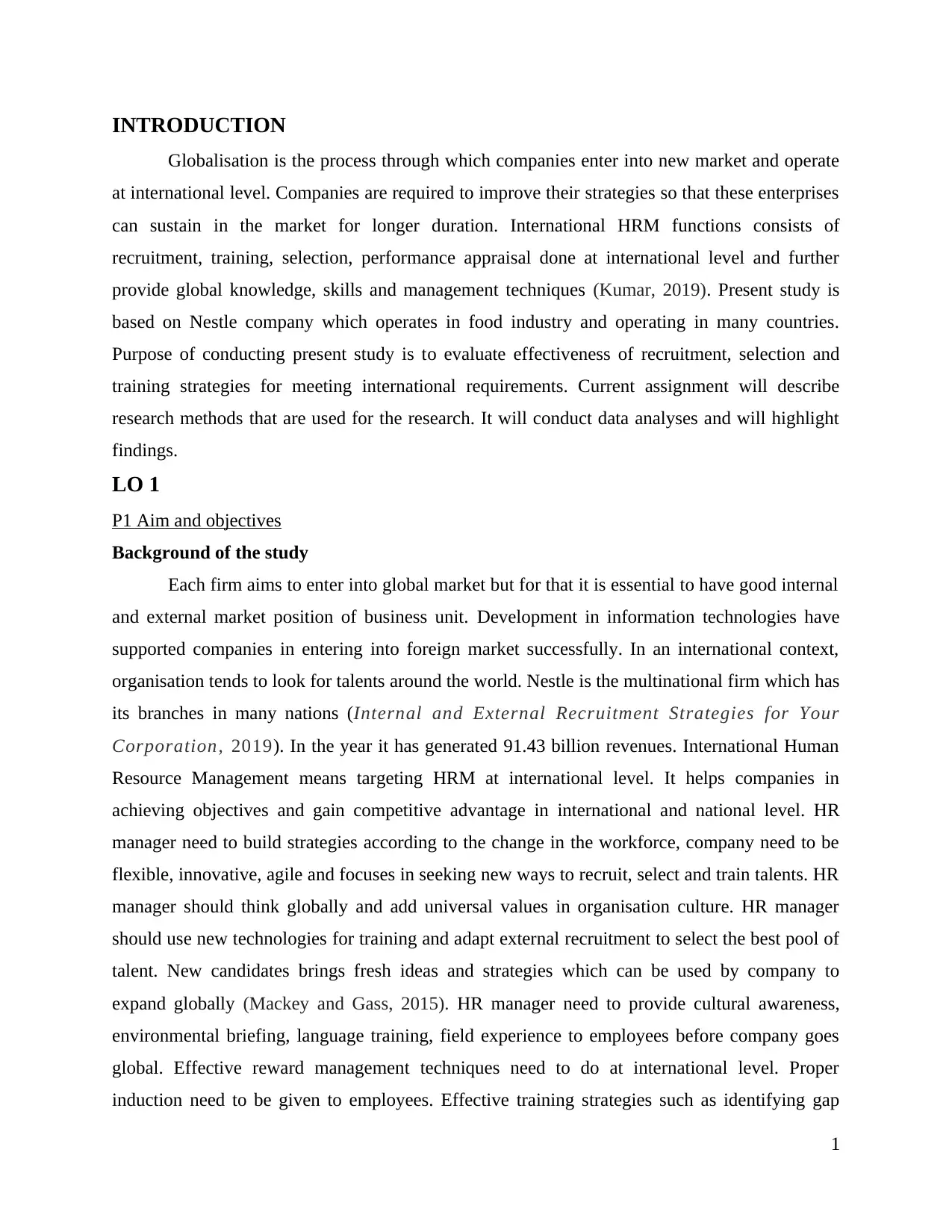
INTRODUCTION
Globalisation is the process through which companies enter into new market and operate
at international level. Companies are required to improve their strategies so that these enterprises
can sustain in the market for longer duration. International HRM functions consists of
recruitment, training, selection, performance appraisal done at international level and further
provide global knowledge, skills and management techniques (Kumar, 2019). Present study is
based on Nestle company which operates in food industry and operating in many countries.
Purpose of conducting present study is to evaluate effectiveness of recruitment, selection and
training strategies for meeting international requirements. Current assignment will describe
research methods that are used for the research. It will conduct data analyses and will highlight
findings.
LO 1
P1 Aim and objectives
Background of the study
Each firm aims to enter into global market but for that it is essential to have good internal
and external market position of business unit. Development in information technologies have
supported companies in entering into foreign market successfully. In an international context,
organisation tends to look for talents around the world. Nestle is the multinational firm which has
its branches in many nations (Internal and External Recruitment Strategies for Your
Corporation, 2019). In the year it has generated 91.43 billion revenues. International Human
Resource Management means targeting HRM at international level. It helps companies in
achieving objectives and gain competitive advantage in international and national level. HR
manager need to build strategies according to the change in the workforce, company need to be
flexible, innovative, agile and focuses in seeking new ways to recruit, select and train talents. HR
manager should think globally and add universal values in organisation culture. HR manager
should use new technologies for training and adapt external recruitment to select the best pool of
talent. New candidates brings fresh ideas and strategies which can be used by company to
expand globally (Mackey and Gass, 2015). HR manager need to provide cultural awareness,
environmental briefing, language training, field experience to employees before company goes
global. Effective reward management techniques need to do at international level. Proper
induction need to be given to employees. Effective training strategies such as identifying gap
1
Globalisation is the process through which companies enter into new market and operate
at international level. Companies are required to improve their strategies so that these enterprises
can sustain in the market for longer duration. International HRM functions consists of
recruitment, training, selection, performance appraisal done at international level and further
provide global knowledge, skills and management techniques (Kumar, 2019). Present study is
based on Nestle company which operates in food industry and operating in many countries.
Purpose of conducting present study is to evaluate effectiveness of recruitment, selection and
training strategies for meeting international requirements. Current assignment will describe
research methods that are used for the research. It will conduct data analyses and will highlight
findings.
LO 1
P1 Aim and objectives
Background of the study
Each firm aims to enter into global market but for that it is essential to have good internal
and external market position of business unit. Development in information technologies have
supported companies in entering into foreign market successfully. In an international context,
organisation tends to look for talents around the world. Nestle is the multinational firm which has
its branches in many nations (Internal and External Recruitment Strategies for Your
Corporation, 2019). In the year it has generated 91.43 billion revenues. International Human
Resource Management means targeting HRM at international level. It helps companies in
achieving objectives and gain competitive advantage in international and national level. HR
manager need to build strategies according to the change in the workforce, company need to be
flexible, innovative, agile and focuses in seeking new ways to recruit, select and train talents. HR
manager should think globally and add universal values in organisation culture. HR manager
should use new technologies for training and adapt external recruitment to select the best pool of
talent. New candidates brings fresh ideas and strategies which can be used by company to
expand globally (Mackey and Gass, 2015). HR manager need to provide cultural awareness,
environmental briefing, language training, field experience to employees before company goes
global. Effective reward management techniques need to do at international level. Proper
induction need to be given to employees. Effective training strategies such as identifying gap
1
⊘ This is a preview!⊘
Do you want full access?
Subscribe today to unlock all pages.

Trusted by 1+ million students worldwide
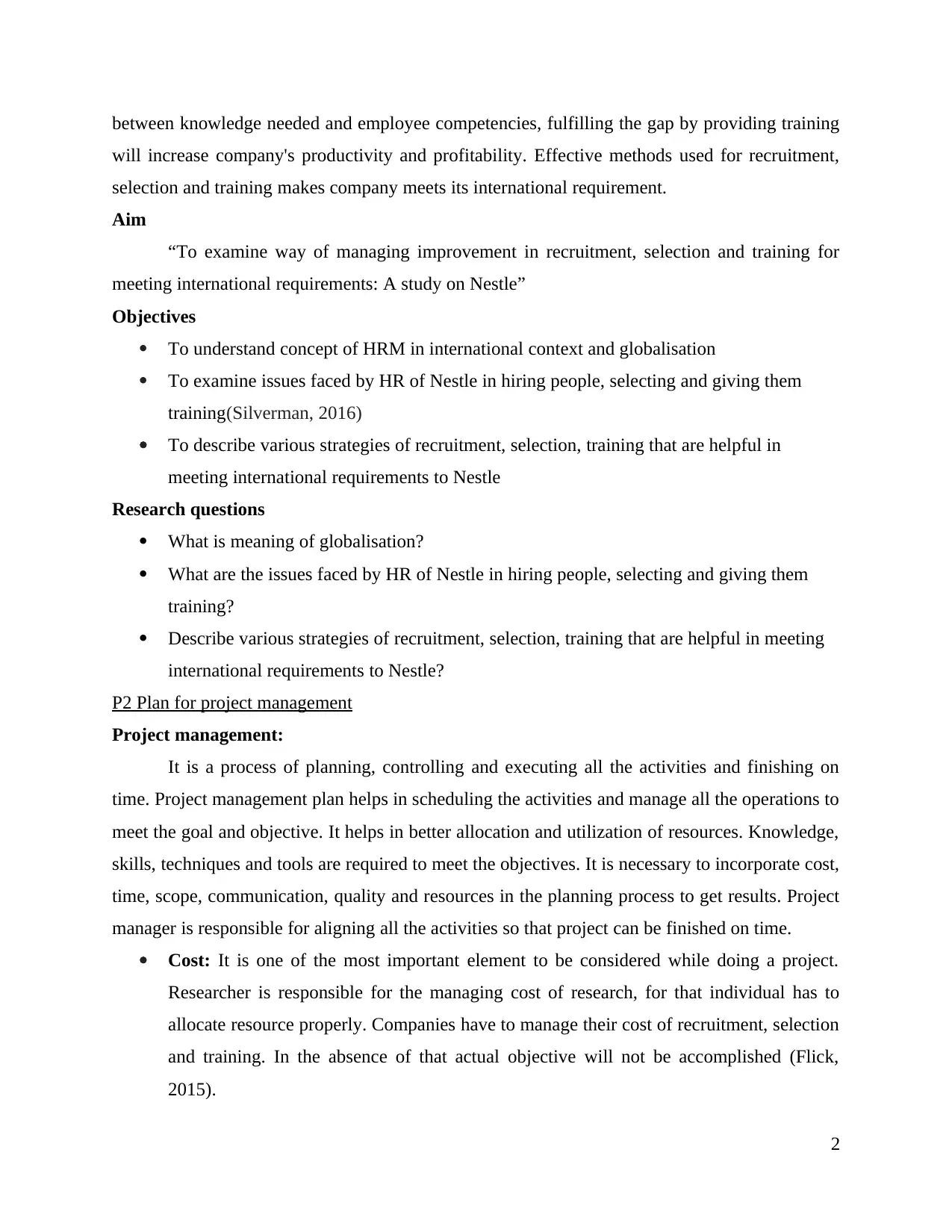
between knowledge needed and employee competencies, fulfilling the gap by providing training
will increase company's productivity and profitability. Effective methods used for recruitment,
selection and training makes company meets its international requirement.
Aim
“To examine way of managing improvement in recruitment, selection and training for
meeting international requirements: A study on Nestle”
Objectives
To understand concept of HRM in international context and globalisation
To examine issues faced by HR of Nestle in hiring people, selecting and giving them
training(Silverman, 2016)
To describe various strategies of recruitment, selection, training that are helpful in
meeting international requirements to Nestle
Research questions
What is meaning of globalisation?
What are the issues faced by HR of Nestle in hiring people, selecting and giving them
training?
Describe various strategies of recruitment, selection, training that are helpful in meeting
international requirements to Nestle?
P2 Plan for project management
Project management:
It is a process of planning, controlling and executing all the activities and finishing on
time. Project management plan helps in scheduling the activities and manage all the operations to
meet the goal and objective. It helps in better allocation and utilization of resources. Knowledge,
skills, techniques and tools are required to meet the objectives. It is necessary to incorporate cost,
time, scope, communication, quality and resources in the planning process to get results. Project
manager is responsible for aligning all the activities so that project can be finished on time.
Cost: It is one of the most important element to be considered while doing a project.
Researcher is responsible for the managing cost of research, for that individual has to
allocate resource properly. Companies have to manage their cost of recruitment, selection
and training. In the absence of that actual objective will not be accomplished (Flick,
2015).
2
will increase company's productivity and profitability. Effective methods used for recruitment,
selection and training makes company meets its international requirement.
Aim
“To examine way of managing improvement in recruitment, selection and training for
meeting international requirements: A study on Nestle”
Objectives
To understand concept of HRM in international context and globalisation
To examine issues faced by HR of Nestle in hiring people, selecting and giving them
training(Silverman, 2016)
To describe various strategies of recruitment, selection, training that are helpful in
meeting international requirements to Nestle
Research questions
What is meaning of globalisation?
What are the issues faced by HR of Nestle in hiring people, selecting and giving them
training?
Describe various strategies of recruitment, selection, training that are helpful in meeting
international requirements to Nestle?
P2 Plan for project management
Project management:
It is a process of planning, controlling and executing all the activities and finishing on
time. Project management plan helps in scheduling the activities and manage all the operations to
meet the goal and objective. It helps in better allocation and utilization of resources. Knowledge,
skills, techniques and tools are required to meet the objectives. It is necessary to incorporate cost,
time, scope, communication, quality and resources in the planning process to get results. Project
manager is responsible for aligning all the activities so that project can be finished on time.
Cost: It is one of the most important element to be considered while doing a project.
Researcher is responsible for the managing cost of research, for that individual has to
allocate resource properly. Companies have to manage their cost of recruitment, selection
and training. In the absence of that actual objective will not be accomplished (Flick,
2015).
2
Paraphrase This Document
Need a fresh take? Get an instant paraphrase of this document with our AI Paraphraser
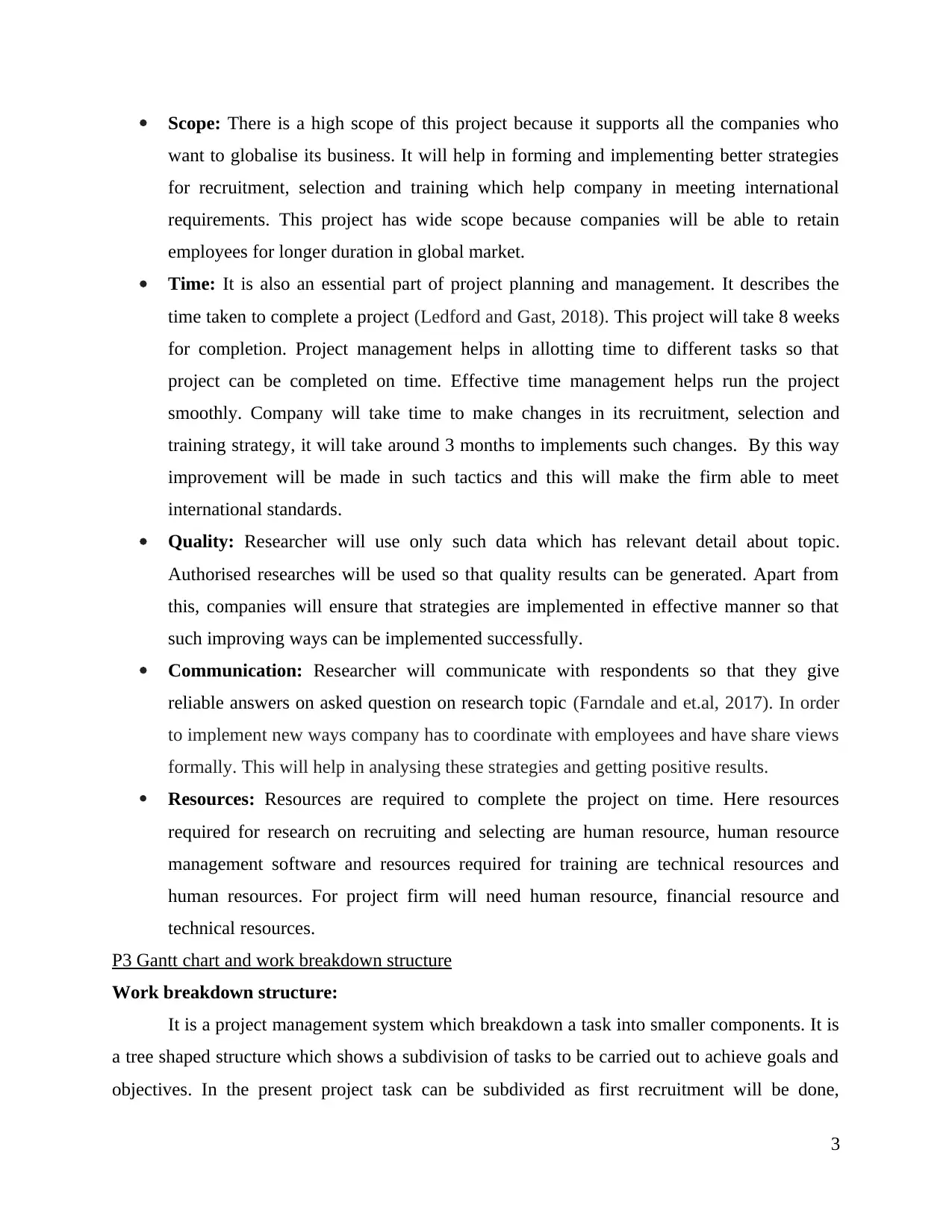
Scope: There is a high scope of this project because it supports all the companies who
want to globalise its business. It will help in forming and implementing better strategies
for recruitment, selection and training which help company in meeting international
requirements. This project has wide scope because companies will be able to retain
employees for longer duration in global market.
Time: It is also an essential part of project planning and management. It describes the
time taken to complete a project (Ledford and Gast, 2018). This project will take 8 weeks
for completion. Project management helps in allotting time to different tasks so that
project can be completed on time. Effective time management helps run the project
smoothly. Company will take time to make changes in its recruitment, selection and
training strategy, it will take around 3 months to implements such changes. By this way
improvement will be made in such tactics and this will make the firm able to meet
international standards.
Quality: Researcher will use only such data which has relevant detail about topic.
Authorised researches will be used so that quality results can be generated. Apart from
this, companies will ensure that strategies are implemented in effective manner so that
such improving ways can be implemented successfully.
Communication: Researcher will communicate with respondents so that they give
reliable answers on asked question on research topic (Farndale and et.al, 2017). In order
to implement new ways company has to coordinate with employees and have share views
formally. This will help in analysing these strategies and getting positive results.
Resources: Resources are required to complete the project on time. Here resources
required for research on recruiting and selecting are human resource, human resource
management software and resources required for training are technical resources and
human resources. For project firm will need human resource, financial resource and
technical resources.
P3 Gantt chart and work breakdown structure
Work breakdown structure:
It is a project management system which breakdown a task into smaller components. It is
a tree shaped structure which shows a subdivision of tasks to be carried out to achieve goals and
objectives. In the present project task can be subdivided as first recruitment will be done,
3
want to globalise its business. It will help in forming and implementing better strategies
for recruitment, selection and training which help company in meeting international
requirements. This project has wide scope because companies will be able to retain
employees for longer duration in global market.
Time: It is also an essential part of project planning and management. It describes the
time taken to complete a project (Ledford and Gast, 2018). This project will take 8 weeks
for completion. Project management helps in allotting time to different tasks so that
project can be completed on time. Effective time management helps run the project
smoothly. Company will take time to make changes in its recruitment, selection and
training strategy, it will take around 3 months to implements such changes. By this way
improvement will be made in such tactics and this will make the firm able to meet
international standards.
Quality: Researcher will use only such data which has relevant detail about topic.
Authorised researches will be used so that quality results can be generated. Apart from
this, companies will ensure that strategies are implemented in effective manner so that
such improving ways can be implemented successfully.
Communication: Researcher will communicate with respondents so that they give
reliable answers on asked question on research topic (Farndale and et.al, 2017). In order
to implement new ways company has to coordinate with employees and have share views
formally. This will help in analysing these strategies and getting positive results.
Resources: Resources are required to complete the project on time. Here resources
required for research on recruiting and selecting are human resource, human resource
management software and resources required for training are technical resources and
human resources. For project firm will need human resource, financial resource and
technical resources.
P3 Gantt chart and work breakdown structure
Work breakdown structure:
It is a project management system which breakdown a task into smaller components. It is
a tree shaped structure which shows a subdivision of tasks to be carried out to achieve goals and
objectives. In the present project task can be subdivided as first recruitment will be done,
3
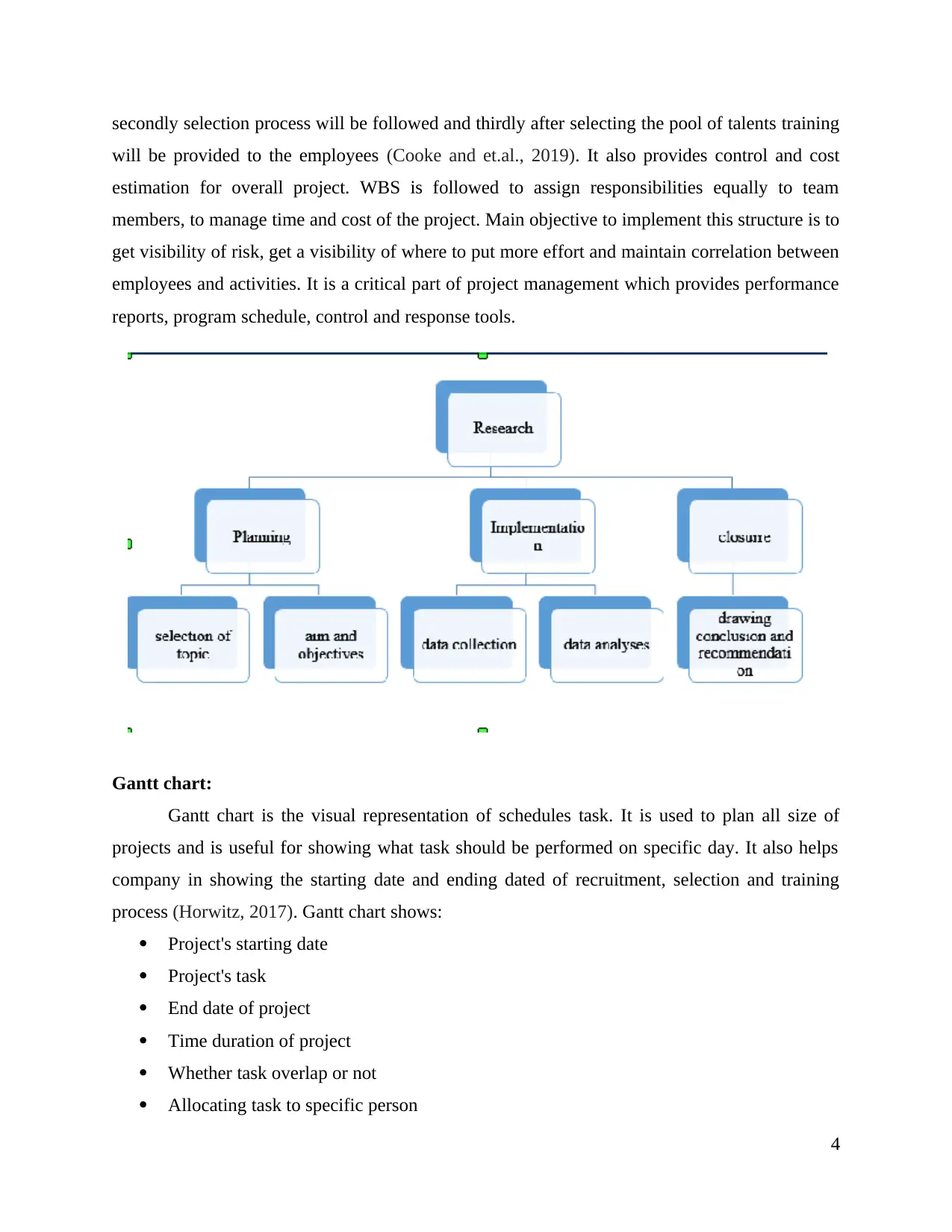
secondly selection process will be followed and thirdly after selecting the pool of talents training
will be provided to the employees (Cooke and et.al., 2019). It also provides control and cost
estimation for overall project. WBS is followed to assign responsibilities equally to team
members, to manage time and cost of the project. Main objective to implement this structure is to
get visibility of risk, get a visibility of where to put more effort and maintain correlation between
employees and activities. It is a critical part of project management which provides performance
reports, program schedule, control and response tools.
Gantt chart:
Gantt chart is the visual representation of schedules task. It is used to plan all size of
projects and is useful for showing what task should be performed on specific day. It also helps
company in showing the starting date and ending dated of recruitment, selection and training
process (Horwitz, 2017). Gantt chart shows:
Project's starting date
Project's task
End date of project
Time duration of project
Whether task overlap or not
Allocating task to specific person
4
will be provided to the employees (Cooke and et.al., 2019). It also provides control and cost
estimation for overall project. WBS is followed to assign responsibilities equally to team
members, to manage time and cost of the project. Main objective to implement this structure is to
get visibility of risk, get a visibility of where to put more effort and maintain correlation between
employees and activities. It is a critical part of project management which provides performance
reports, program schedule, control and response tools.
Gantt chart:
Gantt chart is the visual representation of schedules task. It is used to plan all size of
projects and is useful for showing what task should be performed on specific day. It also helps
company in showing the starting date and ending dated of recruitment, selection and training
process (Horwitz, 2017). Gantt chart shows:
Project's starting date
Project's task
End date of project
Time duration of project
Whether task overlap or not
Allocating task to specific person
4
⊘ This is a preview!⊘
Do you want full access?
Subscribe today to unlock all pages.

Trusted by 1+ million students worldwide
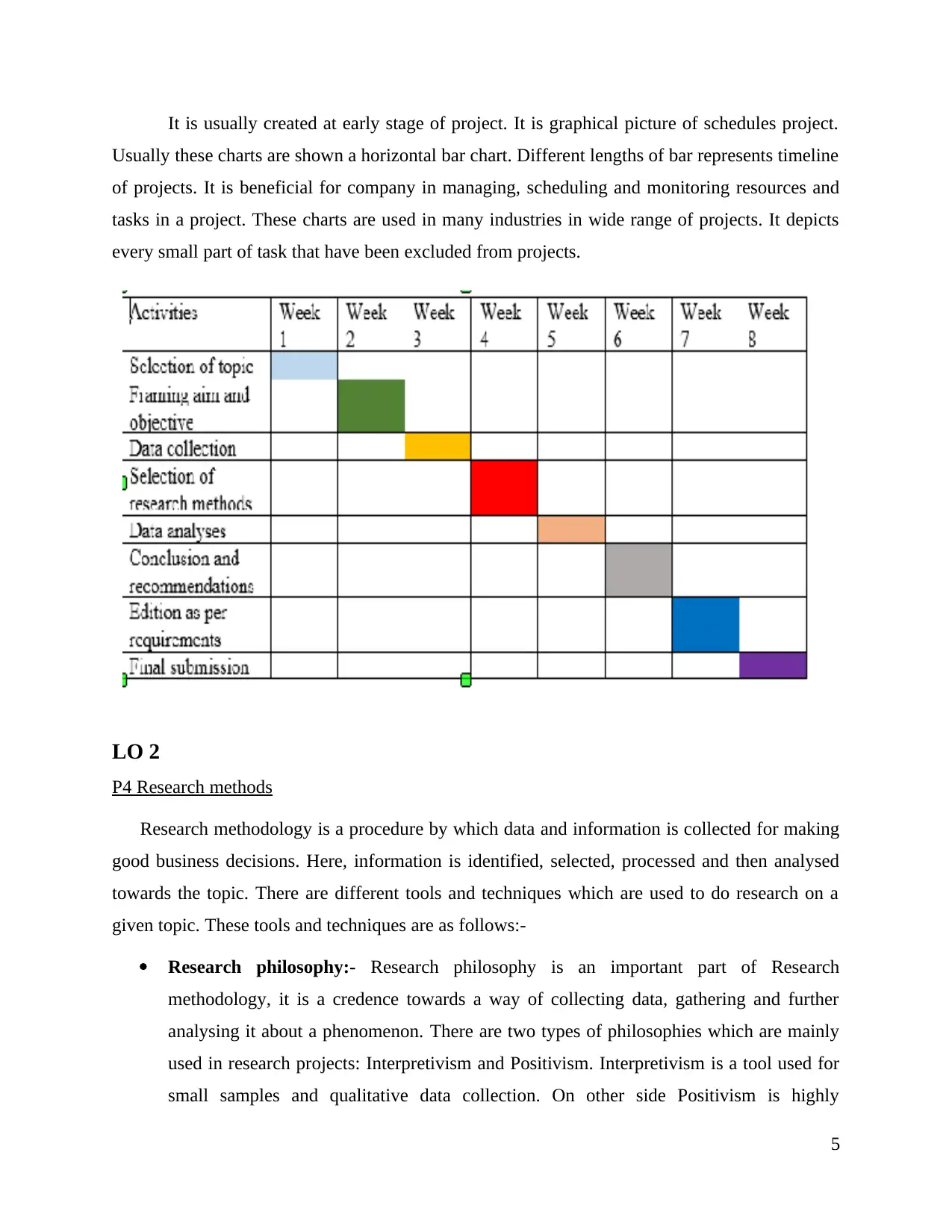
It is usually created at early stage of project. It is graphical picture of schedules project.
Usually these charts are shown a horizontal bar chart. Different lengths of bar represents timeline
of projects. It is beneficial for company in managing, scheduling and monitoring resources and
tasks in a project. These charts are used in many industries in wide range of projects. It depicts
every small part of task that have been excluded from projects.
LO 2
P4 Research methods
Research methodology is a procedure by which data and information is collected for making
good business decisions. Here, information is identified, selected, processed and then analysed
towards the topic. There are different tools and techniques which are used to do research on a
given topic. These tools and techniques are as follows:-
Research philosophy:- Research philosophy is an important part of Research
methodology, it is a credence towards a way of collecting data, gathering and further
analysing it about a phenomenon. There are two types of philosophies which are mainly
used in research projects: Interpretivism and Positivism. Interpretivism is a tool used for
small samples and qualitative data collection. On other side Positivism is highly
5
Usually these charts are shown a horizontal bar chart. Different lengths of bar represents timeline
of projects. It is beneficial for company in managing, scheduling and monitoring resources and
tasks in a project. These charts are used in many industries in wide range of projects. It depicts
every small part of task that have been excluded from projects.
LO 2
P4 Research methods
Research methodology is a procedure by which data and information is collected for making
good business decisions. Here, information is identified, selected, processed and then analysed
towards the topic. There are different tools and techniques which are used to do research on a
given topic. These tools and techniques are as follows:-
Research philosophy:- Research philosophy is an important part of Research
methodology, it is a credence towards a way of collecting data, gathering and further
analysing it about a phenomenon. There are two types of philosophies which are mainly
used in research projects: Interpretivism and Positivism. Interpretivism is a tool used for
small samples and qualitative data collection. On other side Positivism is highly
5
Paraphrase This Document
Need a fresh take? Get an instant paraphrase of this document with our AI Paraphraser
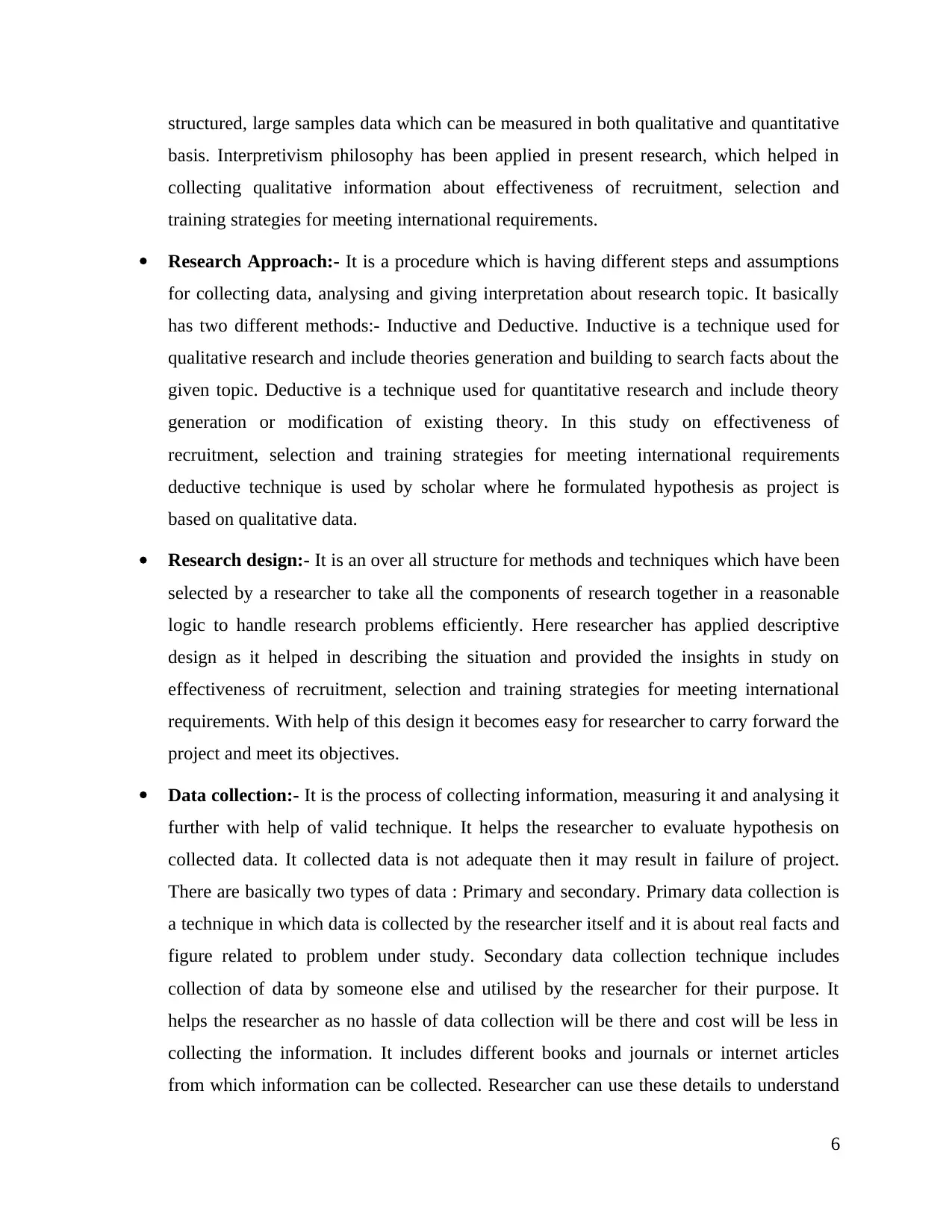
structured, large samples data which can be measured in both qualitative and quantitative
basis. Interpretivism philosophy has been applied in present research, which helped in
collecting qualitative information about effectiveness of recruitment, selection and
training strategies for meeting international requirements.
Research Approach:- It is a procedure which is having different steps and assumptions
for collecting data, analysing and giving interpretation about research topic. It basically
has two different methods:- Inductive and Deductive. Inductive is a technique used for
qualitative research and include theories generation and building to search facts about the
given topic. Deductive is a technique used for quantitative research and include theory
generation or modification of existing theory. In this study on effectiveness of
recruitment, selection and training strategies for meeting international requirements
deductive technique is used by scholar where he formulated hypothesis as project is
based on qualitative data.
Research design:- It is an over all structure for methods and techniques which have been
selected by a researcher to take all the components of research together in a reasonable
logic to handle research problems efficiently. Here researcher has applied descriptive
design as it helped in describing the situation and provided the insights in study on
effectiveness of recruitment, selection and training strategies for meeting international
requirements. With help of this design it becomes easy for researcher to carry forward the
project and meet its objectives.
Data collection:- It is the process of collecting information, measuring it and analysing it
further with help of valid technique. It helps the researcher to evaluate hypothesis on
collected data. It collected data is not adequate then it may result in failure of project.
There are basically two types of data : Primary and secondary. Primary data collection is
a technique in which data is collected by the researcher itself and it is about real facts and
figure related to problem under study. Secondary data collection technique includes
collection of data by someone else and utilised by the researcher for their purpose. It
helps the researcher as no hassle of data collection will be there and cost will be less in
collecting the information. It includes different books and journals or internet articles
from which information can be collected. Researcher can use these details to understand
6
basis. Interpretivism philosophy has been applied in present research, which helped in
collecting qualitative information about effectiveness of recruitment, selection and
training strategies for meeting international requirements.
Research Approach:- It is a procedure which is having different steps and assumptions
for collecting data, analysing and giving interpretation about research topic. It basically
has two different methods:- Inductive and Deductive. Inductive is a technique used for
qualitative research and include theories generation and building to search facts about the
given topic. Deductive is a technique used for quantitative research and include theory
generation or modification of existing theory. In this study on effectiveness of
recruitment, selection and training strategies for meeting international requirements
deductive technique is used by scholar where he formulated hypothesis as project is
based on qualitative data.
Research design:- It is an over all structure for methods and techniques which have been
selected by a researcher to take all the components of research together in a reasonable
logic to handle research problems efficiently. Here researcher has applied descriptive
design as it helped in describing the situation and provided the insights in study on
effectiveness of recruitment, selection and training strategies for meeting international
requirements. With help of this design it becomes easy for researcher to carry forward the
project and meet its objectives.
Data collection:- It is the process of collecting information, measuring it and analysing it
further with help of valid technique. It helps the researcher to evaluate hypothesis on
collected data. It collected data is not adequate then it may result in failure of project.
There are basically two types of data : Primary and secondary. Primary data collection is
a technique in which data is collected by the researcher itself and it is about real facts and
figure related to problem under study. Secondary data collection technique includes
collection of data by someone else and utilised by the researcher for their purpose. It
helps the researcher as no hassle of data collection will be there and cost will be less in
collecting the information. It includes different books and journals or internet articles
from which information can be collected. Researcher can use these details to understand
6
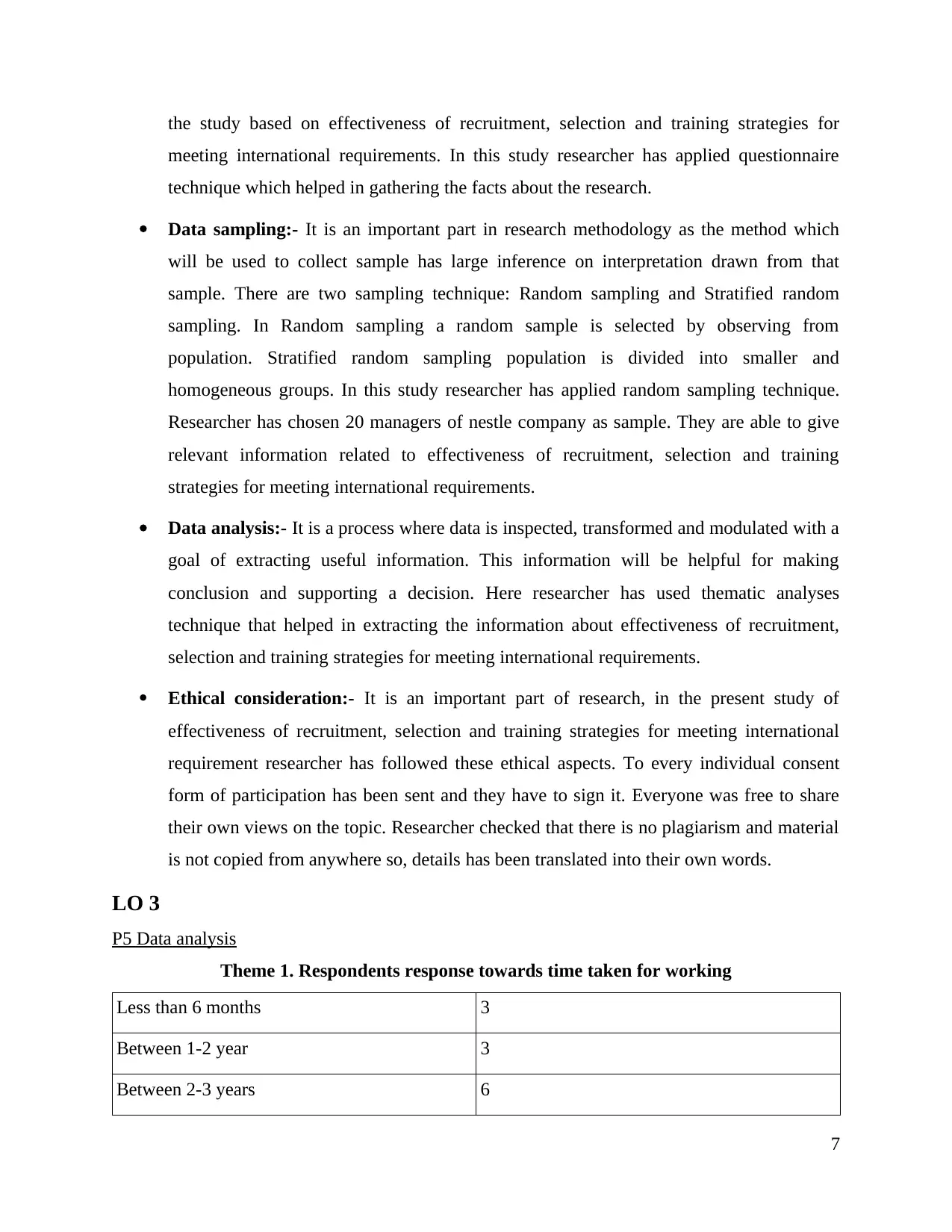
the study based on effectiveness of recruitment, selection and training strategies for
meeting international requirements. In this study researcher has applied questionnaire
technique which helped in gathering the facts about the research.
Data sampling:- It is an important part in research methodology as the method which
will be used to collect sample has large inference on interpretation drawn from that
sample. There are two sampling technique: Random sampling and Stratified random
sampling. In Random sampling a random sample is selected by observing from
population. Stratified random sampling population is divided into smaller and
homogeneous groups. In this study researcher has applied random sampling technique.
Researcher has chosen 20 managers of nestle company as sample. They are able to give
relevant information related to effectiveness of recruitment, selection and training
strategies for meeting international requirements.
Data analysis:- It is a process where data is inspected, transformed and modulated with a
goal of extracting useful information. This information will be helpful for making
conclusion and supporting a decision. Here researcher has used thematic analyses
technique that helped in extracting the information about effectiveness of recruitment,
selection and training strategies for meeting international requirements.
Ethical consideration:- It is an important part of research, in the present study of
effectiveness of recruitment, selection and training strategies for meeting international
requirement researcher has followed these ethical aspects. To every individual consent
form of participation has been sent and they have to sign it. Everyone was free to share
their own views on the topic. Researcher checked that there is no plagiarism and material
is not copied from anywhere so, details has been translated into their own words.
LO 3
P5 Data analysis
Theme 1. Respondents response towards time taken for working
Less than 6 months 3
Between 1-2 year 3
Between 2-3 years 6
7
meeting international requirements. In this study researcher has applied questionnaire
technique which helped in gathering the facts about the research.
Data sampling:- It is an important part in research methodology as the method which
will be used to collect sample has large inference on interpretation drawn from that
sample. There are two sampling technique: Random sampling and Stratified random
sampling. In Random sampling a random sample is selected by observing from
population. Stratified random sampling population is divided into smaller and
homogeneous groups. In this study researcher has applied random sampling technique.
Researcher has chosen 20 managers of nestle company as sample. They are able to give
relevant information related to effectiveness of recruitment, selection and training
strategies for meeting international requirements.
Data analysis:- It is a process where data is inspected, transformed and modulated with a
goal of extracting useful information. This information will be helpful for making
conclusion and supporting a decision. Here researcher has used thematic analyses
technique that helped in extracting the information about effectiveness of recruitment,
selection and training strategies for meeting international requirements.
Ethical consideration:- It is an important part of research, in the present study of
effectiveness of recruitment, selection and training strategies for meeting international
requirement researcher has followed these ethical aspects. To every individual consent
form of participation has been sent and they have to sign it. Everyone was free to share
their own views on the topic. Researcher checked that there is no plagiarism and material
is not copied from anywhere so, details has been translated into their own words.
LO 3
P5 Data analysis
Theme 1. Respondents response towards time taken for working
Less than 6 months 3
Between 1-2 year 3
Between 2-3 years 6
7
⊘ This is a preview!⊘
Do you want full access?
Subscribe today to unlock all pages.

Trusted by 1+ million students worldwide
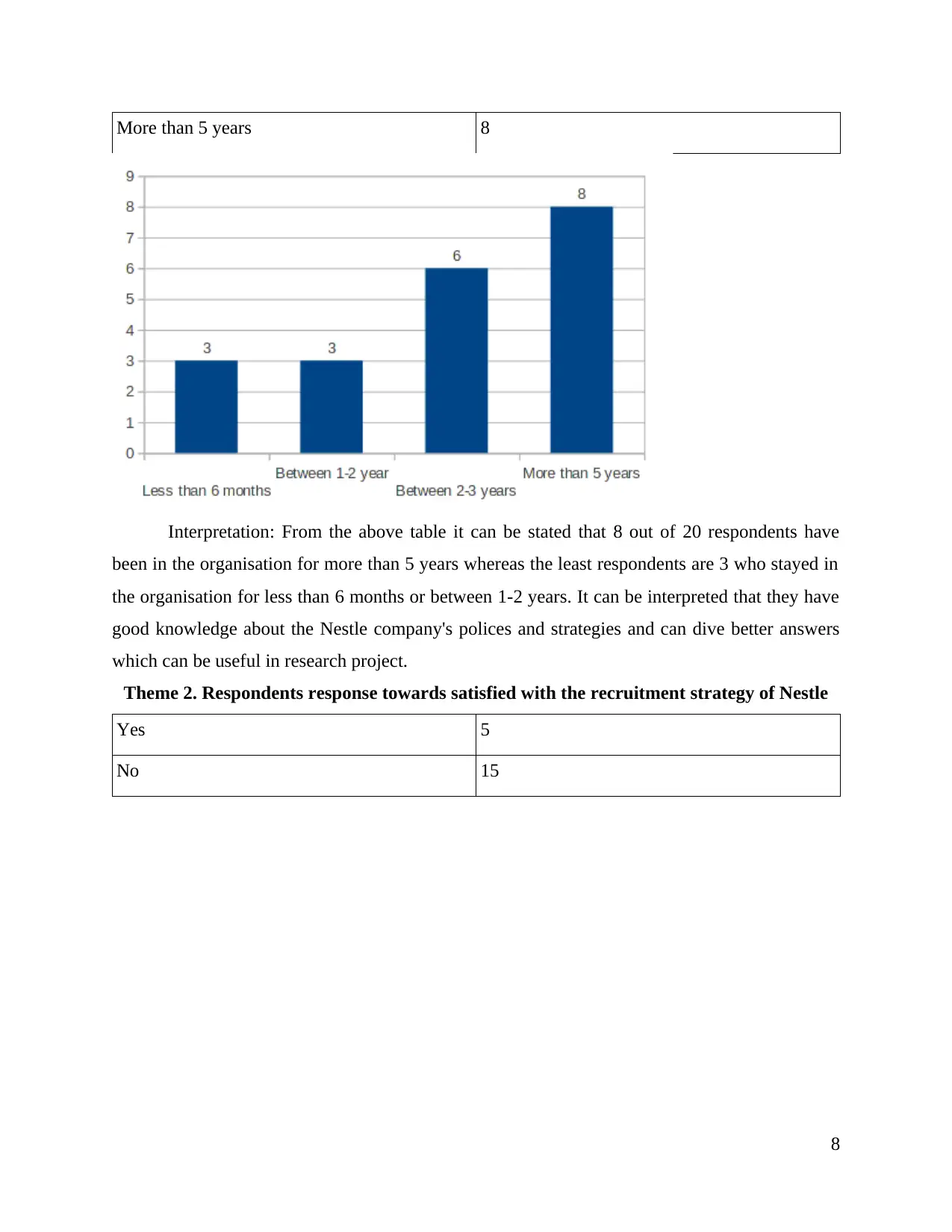
More than 5 years 8
Interpretation: From the above table it can be stated that 8 out of 20 respondents have
been in the organisation for more than 5 years whereas the least respondents are 3 who stayed in
the organisation for less than 6 months or between 1-2 years. It can be interpreted that they have
good knowledge about the Nestle company's polices and strategies and can dive better answers
which can be useful in research project.
Theme 2. Respondents response towards satisfied with the recruitment strategy of Nestle
Yes 5
No 15
8
Interpretation: From the above table it can be stated that 8 out of 20 respondents have
been in the organisation for more than 5 years whereas the least respondents are 3 who stayed in
the organisation for less than 6 months or between 1-2 years. It can be interpreted that they have
good knowledge about the Nestle company's polices and strategies and can dive better answers
which can be useful in research project.
Theme 2. Respondents response towards satisfied with the recruitment strategy of Nestle
Yes 5
No 15
8
Paraphrase This Document
Need a fresh take? Get an instant paraphrase of this document with our AI Paraphraser
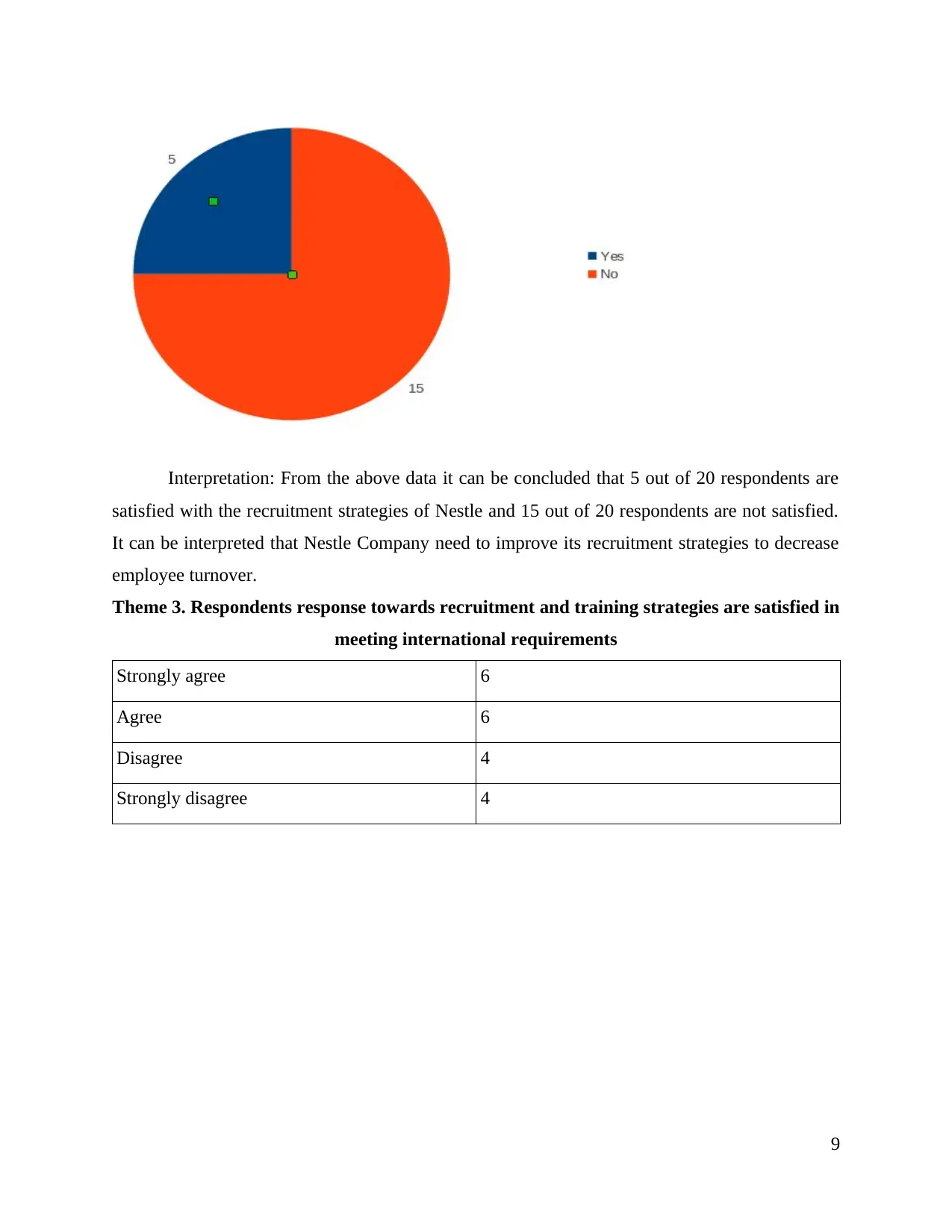
Interpretation: From the above data it can be concluded that 5 out of 20 respondents are
satisfied with the recruitment strategies of Nestle and 15 out of 20 respondents are not satisfied.
It can be interpreted that Nestle Company need to improve its recruitment strategies to decrease
employee turnover.
Theme 3. Respondents response towards recruitment and training strategies are satisfied in
meeting international requirements
Strongly agree 6
Agree 6
Disagree 4
Strongly disagree 4
9
satisfied with the recruitment strategies of Nestle and 15 out of 20 respondents are not satisfied.
It can be interpreted that Nestle Company need to improve its recruitment strategies to decrease
employee turnover.
Theme 3. Respondents response towards recruitment and training strategies are satisfied in
meeting international requirements
Strongly agree 6
Agree 6
Disagree 4
Strongly disagree 4
9
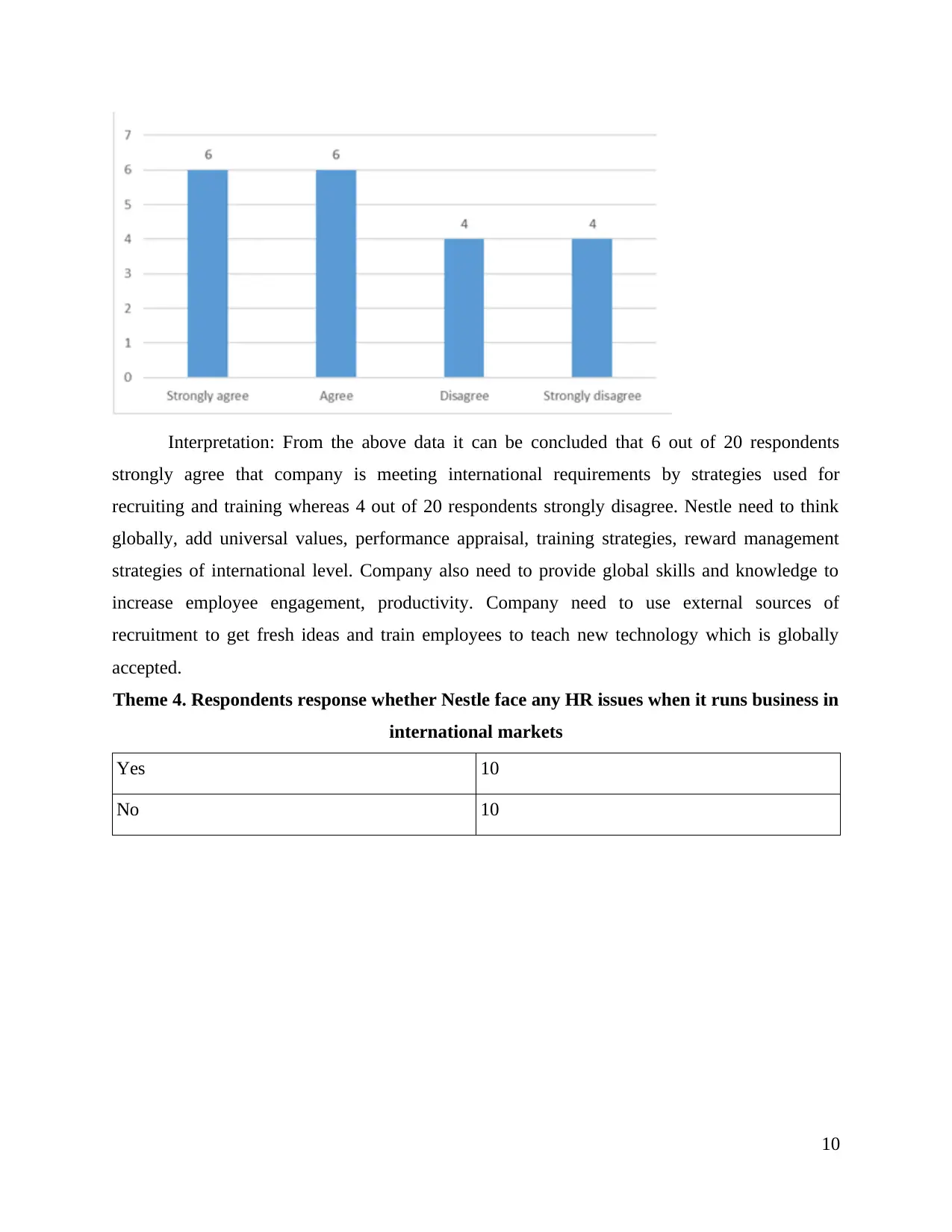
Interpretation: From the above data it can be concluded that 6 out of 20 respondents
strongly agree that company is meeting international requirements by strategies used for
recruiting and training whereas 4 out of 20 respondents strongly disagree. Nestle need to think
globally, add universal values, performance appraisal, training strategies, reward management
strategies of international level. Company also need to provide global skills and knowledge to
increase employee engagement, productivity. Company need to use external sources of
recruitment to get fresh ideas and train employees to teach new technology which is globally
accepted.
Theme 4. Respondents response whether Nestle face any HR issues when it runs business in
international markets
Yes 10
No 10
10
strongly agree that company is meeting international requirements by strategies used for
recruiting and training whereas 4 out of 20 respondents strongly disagree. Nestle need to think
globally, add universal values, performance appraisal, training strategies, reward management
strategies of international level. Company also need to provide global skills and knowledge to
increase employee engagement, productivity. Company need to use external sources of
recruitment to get fresh ideas and train employees to teach new technology which is globally
accepted.
Theme 4. Respondents response whether Nestle face any HR issues when it runs business in
international markets
Yes 10
No 10
10
⊘ This is a preview!⊘
Do you want full access?
Subscribe today to unlock all pages.

Trusted by 1+ million students worldwide
1 out of 23
Related Documents
Your All-in-One AI-Powered Toolkit for Academic Success.
+13062052269
info@desklib.com
Available 24*7 on WhatsApp / Email
![[object Object]](/_next/static/media/star-bottom.7253800d.svg)
Unlock your academic potential
Copyright © 2020–2025 A2Z Services. All Rights Reserved. Developed and managed by ZUCOL.





